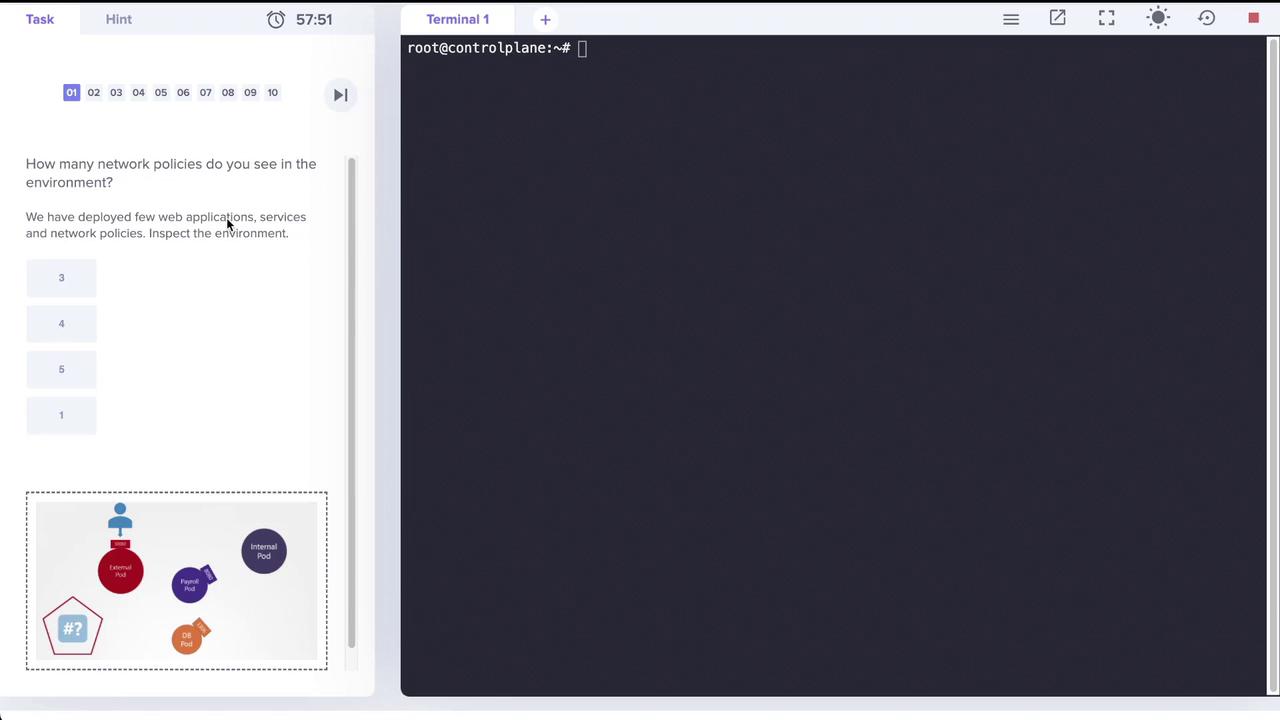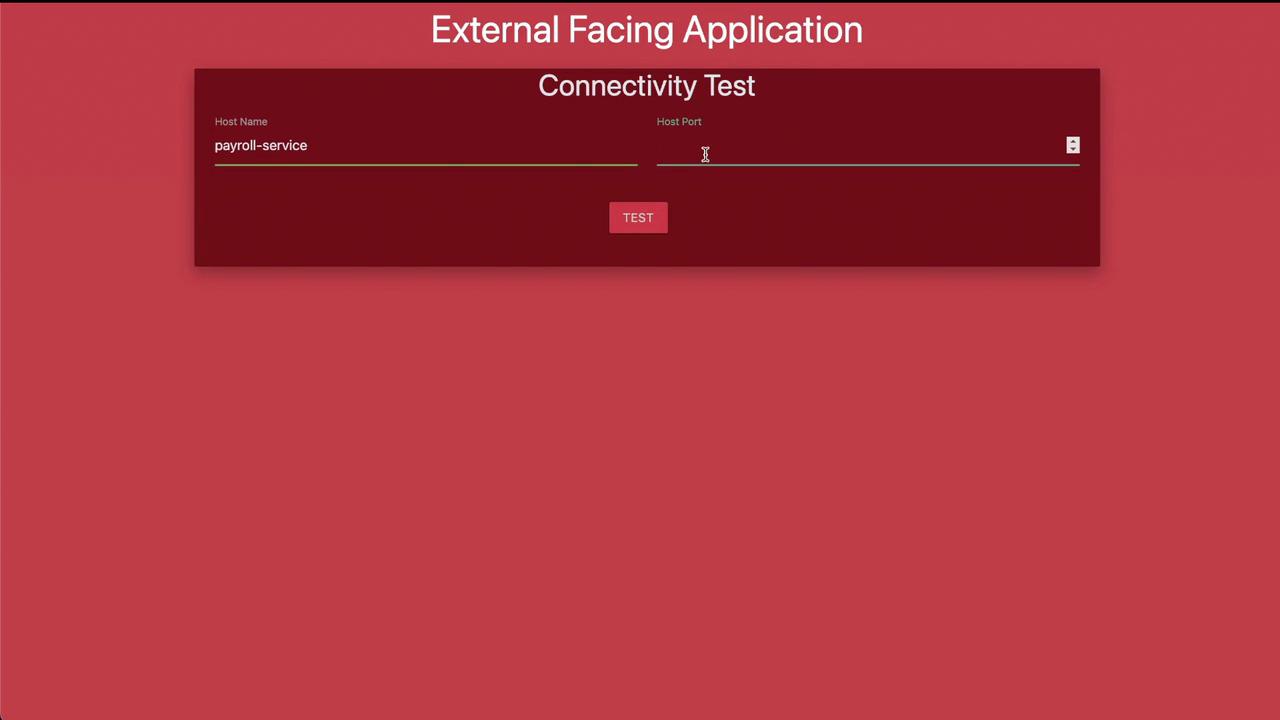CKA Certification Course - Certified Kubernetes Administrator
Security
Solution Network Policies optional
In this lesson, we review a practical test on network policies within a Kubernetes environment. The lab deploys several web applications, services, and network policies. Your objective is to inspect the environment and answer questions related to the applied network policies.

Step 1: Inspecting the Pods
First, verify the running applications by listing the pods. In this environment, four pods are running: external, internal, mysql (the database), and payroll. Execute the following command:
root@controlplane:~# kubectl get pods
NAME READY STATUS RESTARTS AGE
external 1/1 Running 0 2m20s
internal 1/1 Running 0 2m19s
mysql 1/1 Running 0 2m19s
payroll 1/1 Running 0 2m19s
Step 2: Checking the Associated Services
Next, inspect the services that expose these pods on different ports. Note that:
- The payroll service is exposed on port 8080.
- Both the external and internal services also use port 8080.
- The MySQL (DB) service is available on port 3306.
Run this command to list the services:
root@controlplane:~# kubectl get service
NAME TYPE CLUSTER-IP EXTERNAL-IP PORT(S) AGE
db-service ClusterIP 10.109.89.42 <none> 3306/TCP 2m42s
external-service NodePort 10.108.170.44 <none> 8080:30000/TCP 2m42s
internal-service NodePort 10.98.11.243 <none> 8080:30082/TCP 2m42s
kubernetes ClusterIP 10.96.0.1 <none> 443/TCP 39m
payroll-service NodePort 10.110.165.31 <none> 8080:30083/TCP 2m42s
Step 3: Identifying Network Policies
The next step is to check the applied network policies. Initially, running:
root@controlplane:~# kubectl get networkpolicies
error: the server doesn't have a resource type "networkpolicies"
Then, using the shorthand command:
root@controlplane:~# kubectl get netpol
NAME POD-SELECTOR AGE
payroll-policy name=payroll 3m31s
The output shows a single network policy, payroll-policy, which applies to the pod labeled name=payroll.
Policy Details
The payroll network policy allows ingress TCP traffic on port 8080 to the payroll pod, but only from pods with the name=internal label. Outbound traffic (egress) is not restricted.
Step 4: Reviewing the Payroll Network Policy
Inspect the details of the network policy with the following command:
root@controlplane:~# kubectl describe netpol payroll-policy
Name: payroll-policy
Namespace: default
Created on: 2022-04-18 20:35:54 +0000 UTC
Labels: <none>
Annotations: <none>
Spec:
PodSelector: name=payroll
Allowing ingress traffic:
To Port: 8080/TCP
From:
PodSelector: name=internal
Not affecting egress traffic
Policy Types: Ingress
This confirms that only traffic from pods labeled name=internal is permitted to access the payroll pod on TCP port 8080.
Step 5: Connectivity Tests
Connectivity tests via the provided application interfaces validate that:
- The internal-facing application successfully accesses the payroll service on port 8080.
- The external-facing application times out when attempting to access the same service.

This behavior verifies that the network policy is correctly enforcing restricted access based on the pod labels.
Step 6: Creating a New Network Policy for Internal Pod Egress
The next task is to create a network policy that further restricts the internal pod's egress traffic. The goal is to allow the internal pod only to access:
- The payroll pod on port 8080.
- The MySQL (DB) pod on port 3306.
Create a file named internal-policy.yaml with the following content:
apiVersion: networking.k8s.io/v1
kind: NetworkPolicy
metadata:
name: internal-policy
namespace: default
spec:
# This policy applies to the internal pod.
podSelector:
matchLabels:
name: internal
policyTypes:
- Ingress
- Egress
# Ingress traffic remains unrestricted.
egress:
# Allow egress traffic to the payroll pod on TCP port 8080.
- to:
podSelector:
matchLabels:
name: payroll
ports:
- protocol: TCP
port: 8080
# Allow egress traffic to the MySQL (DB) pod on TCP port 3306.
- to:
podSelector:
matchLabels:
name: mysql
ports:
- protocol: TCP
port: 3306
Apply this network policy with the following command:
root@controlplane:~# kubectl create -f internal-policy.yaml
networkpolicy.networking.k8s.io/internal-policy created
Verify the applied policy:
root@controlplane:~# kubectl describe netpol internal-policy
Name: internal-policy
Namespace: default
Created on: 2022-04-18 20:53:13 +0000 UTC
Labels: <none>
Annotations: <none>
Spec:
PodSelector: name=internal
Not affecting ingress traffic
Allowing egress traffic:
To:
PodSelector: name=payroll
To Port: 8080/TCP
To:
PodSelector: name=mysql
To Port: 3306/TCP
Policy Types: Egress
Final Outcome
The internal policy ensures that the internal pod can only send egress traffic to the payroll pod on port 8080 and the MySQL pod on port 3306, effectively blocking any other outbound connections.
This configuration confirms that the network policies enforce the intended connectivity restrictions, completing the lab exercise.
Additional Resources
Watch Video
Watch video content